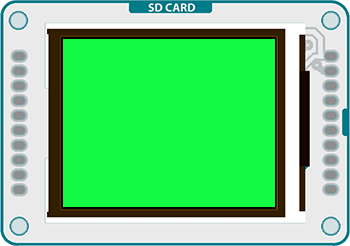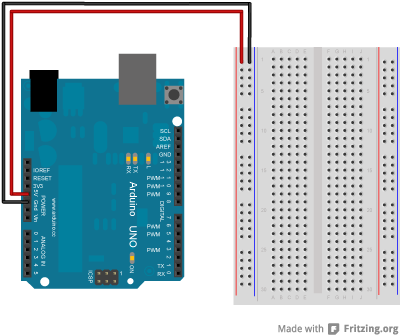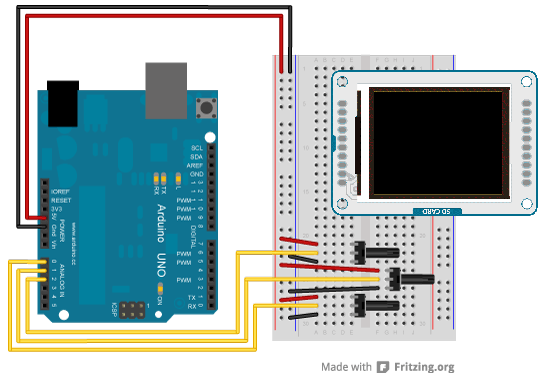Examples > TFT
TFT Color Picker

This example for the Arduino TFT screen reads the input of three analog sensors, using the values to change the screen's color.
Color on the TFT screen is handled as 8-bit numbers (0-255). However, the library scales these values to 5-bits (32 levels) for red and blue, 6-bits (64 levels) for green.
Hardware Required
- Arduino Uno
- Arduino TFT screen
- breadboard
- hookup wire
- three 10-kilohm potentiometers
Circuit
Connect power and ground to the breadboard.
Show me how to do thatShow me how to do that
Attach the three pots to the breadboard, connecting their outside legs to power and ground. the center legs should connect to A0-A2.
Show me how to do thatShow me how to do that
Connect the LCD screen to the breadboard. The headers on the side of the screen with the small blue tab and arrow should be the ones that attach to the board. Pay attention to the orientation of the screen, in these images, it is upside down.
Show me how to do thatShow me how to do that
Connect the BL and +5V pins to power, and GND to ground. Connect CS-LD to pin 10, DC to pin 9, RESET to pin 8, MOSI to pin 11, and SCK to pin 13. If you're using a Leonardo, you'll be using different pins. see the getting started page for more details.
Show me how to do thatShow me how to do that
Code
To use the screen you must first include the SPI and TFT libraries.
#include <TFT.h>
Define the pins you're going to use for controlling the screen, and create an instance of the TFT library named TFTscreen. You'll reference that object whenever you're working with the screen.
#define dc 9
#define rst 8
TFT TFTscreen = TFT(cs, dc, rst);
In setup(), initialize the screen and clear the background. Start serial communication as well.
Serial.begin(9600);
TFTscreen.begin();
TFTscreen.background(255, 255, 255);
}
In loop(), read the values fron the pots, mapping them to values between 0-255. with background(), set the mapped background colors and print the values to the serial monitor.
int redVal = map(analogRead(A0), 0, 1023, 0, 255);
int greenVal = map(analogRead(A1), 0, 1023, 0, 255);
int blueVal = map(analogRead(A2), 0, 1023, 0, 255);
TFTscreen.background(redVal, greenVal, blueVal);
Serial.print("background(");
Serial.print(redVal);
Serial.print(" , ");
Serial.print(greenVal);
Serial.print(" , ");
Serial.print(blueVal);
Serial.println(")");
delay(33);
}
The complete sketch is below :
TFT Color Picker
This example for the Arduino screen reads the input of
potentiometers or analog sensors attached to A0, A1,
and A2 and uses the values to change the screen's color.
This example code is in the public domain.
Created 15 April 2013 by Scott Fitzgerald
http://www.arduino.cc/en/Tutorial/TFTColorPicker
*/
// pin definition for the Uno
#define cs 10
#define dc 9
#define rst 8
// pin definition for the Leonardo
// #define cs 7
// #define dc 0
// #define rst 1
#include <TFT.h> // Arduino LCD library
#include <SPI.h>
TFT TFTscreen = TFT(cs, dc, rst);
void setup() {
// begin serial communication
Serial.begin(9600);
// initialize the display
TFTscreen.begin();
// set the background to white
TFTscreen.background(255, 255, 255);
}
void loop() {
// read the values from your sensors and scale them to 0-255
int redVal = map(analogRead(A0), 0, 1023, 0, 255);
int greenVal = map(analogRead(A1), 0, 1023, 0, 255);
int blueVal = map(analogRead(A2), 0, 1023, 0, 255);
// draw the background based on the mapped values
TFTscreen.background(redVal, greenVal, blueVal);
// send the values to the serial monitor
Serial.print("background(");
Serial.print(redVal);
Serial.print(" , ");
Serial.print(greenVal);
Serial.print(" , ");
Serial.print(blueVal);
Serial.println(")");
// wait for a moment
delay(33);
}




